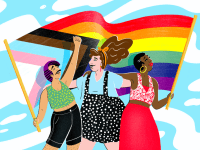10 ways to make your wedding more inclusive, according to an expert
These tips can help every guest feel welcome
Products are chosen independently by our editors. Purchases made through our links may earn us a commission.
Weddings are steeped in rituals, and certain ones—brides wear white dresses, grooms wear suits, and so forth—can be hard to shake. But, now more than ever before, many spouses-to-be are looking to create new traditions that are more open and liberating, not just for themselves but for their friends, families, and loved ones.
“Planning an inclusive wedding is not easy. You'll have to break with couplenormative, heteronormative, and cisnormative rules that have been enforced for centuries," said Sophie Mona Pagès, a relationship expert and founder of LVRSNFRNDS, an inclusivity-driven social networking app.
Much like gender and sexuality, inclusivity is a spectrum, and there are many ways—both big and small—for you to be mindful of it throughout your wedding planning. Even something as simple as reconsidering terms like “bride” and “groom” (experts like gender-inclusive alternatives such as “broom,” “gride,” or “celebrant”) can make a meaningful and effective difference.
So, as you’re dreaming of the picture-perfect ceremony, and preparing for your celebrations, these expert tips, which can help make the event more inviting and gender-inclusive to those you care about, regardless of identity, relationship status, or otherwise.
1. Embrace mixed-gender wedding parties
Incorporating bridesmen and groomsmaids into your wedding party is a fast-growing trend in the U.S., and it’s great for several reasons. It allows you to have a wedding party that includes your nearest and dearest and helps make folks of all genders feel more accepted at your wedding.
“And don’t force opposite-sex pairings,” urged Pagès. “Let people in your wedding party walk up the aisle with the person they want to.” You may also want to consider this for roles like “flower girl” or “ring bearer” as any special children in your life might be a perfect fit, depending on their interests.
2. Find LGBTQ+-friendly vendors
“There are so many wedding vendors out there that will encourage you to have a more inclusive wedding and can often provide many different tips to make the process easier,” said Brianna Parks, an elopement photographer.
Finding an equality-focused vendor for everything from photos to floral arrangements and more can help you have the inclusive wedding of your dreams, but it’s not always easy to tell if a vendor meets those requirements.
If you’re eager to find LGBTQ+ friendly vendors in your area, Love Inc., an equality-focused wedding publication, features comprehensive listings that can help you refine your search. Also, check a vendor’s website or ask directly if they’ve attended workshops through The Gay Wedding Institute, which helps educate wedding professionals on how to make their businesses more LGBTQ+ inclusive.
3. Choose an inclusive venue
Experts say it’s essential to make sure your venue has gender-neutral bathrooms and that those are readily available to all guests in attendance. If not, you run the risk of making these crucial people in your life feel less seen and valued at your wedding.
4. Invite anyone you want to pre-wedding events
Gone are the days of keeping pre-wedding events strictly gendered. Looking for an easy way to make your wedding feel more welcoming for all? According to Pagès, invite anyone you love to your pre-nuptial celebrations, whether that be a bachelorette party, couples shower, or any other celebration. The more, the merrier!
5. Skip the titles on your invites (and offer a plus one)
When it comes to addressing wedding invitations, honorifics—a.k.a., titles like “Mr.,” “Mrs.,” and so forth—might seem like an Emily Post-approved move in the lead-up to your big day, but experts say it isn’t. Not in this day and age, anyway.
Rather, address all invitations using a guest’s full name. Also, consider encouraging each guest to bring along a plus one, regardless of whether they appear to be in a relationship or not. “[By doing this], you signify that all partners are valid, romantic or not,” said Pagès.
6. Use pronouns on place cards or name tags
Using correct pronouns is one of the most straightforward yet meaningful ways to show respect for someone’s identity, and experts say that encouraging all wedding guests to do so can make your event more inclusive.
What is a good way to do this? Ask all guests to specify their pronouns and use them on place cards or name tags. “This is a great way to avoid the awkward question of, ‘What are your pronouns?’ to guests you've never met before,” said Parks.
7. Don’t enforce a gendered dress code
“Enforcing gender-normative rules on what guests can wear, [like] dresses for ‘women' and suits for ‘men,’ can discourage people who don't fit into that bubble from attending,” said Pagès.
Instead of adhering to a strict gendered dress code, encourage guests to wear what they feel comfortable in and what flatters their bodies. You can still clarify whether this means casual or formal attire is preferred, especially if you’re going for a ballroom aesthetic on your big day. But letting the attendees at your ceremony know that they don’t have to dress a certain way based on traditional gender norms can feel like a huge weight lifted, and goes a long way toward honoring inclusivity and diversity.
8. Go with an informal seating arrangement
Ensuring that pronouns are on all place cards or name tags is a respectful gesture that can help ensure every guest at your wedding feels recognized and valued in their gender identity.
Another move—which is inclusive toward all guests, regardless of relationship status—is to consider an informal seating arrangement. “It eradicates that dreadful singles table, which makes folks feel left out and infers that they can only mingle with other single people,” said Pagès.
Depending on your wedding location or choice of venue, an informal seating arrangement can take many forms but essentially allows guests to choose where they’d like to sit. It also invites others to mingle freely and openly throughout the festivities, so no one feels confined to a particular chair or table.
9. Ask your DJ to use gender-inclusive language
Traditionally speaking, weddings are full of gendered language—best man, maid of honor, and countless other examples abound.
Experts recommend talking to your DJ or master of ceremonies before the event and requesting that they use inclusive language when calling attention to members of the wedding party or inviting guests to join on the dance floor. If they’re unclear about inclusive alternatives, consider providing a list of terms in advance, so they can be better informed once the big day arrives. Not everyone is a “lady” or “gentleman,” but everyone can be a “party person.”
10. Open up the bouquet toss
Flowers are a highlight at most weddings. While traditionally, the bride carries a bouquet (as well as members of the bride’s wedding party), a great way to make festivities more inclusive is to consider having both partners carry one or allowing members of either wedding party to rock one.
But why stop there? The bouquet toss doesn’t have to be limited to one gender. Experts urge couples to open it up to any guests who’d like to participate. “Instead of separating these two traditions by gender, allow everyone to partake in the fun,” said Parks.
While it might seem small, gestures like this help put guests at ease and get your marriage off to a warm and lovely start.
The product experts at Reviewed have all your shopping needs covered. Follow Reviewed on Facebook, Twitter, and Instagram for the latest deals, product reviews, and more.



